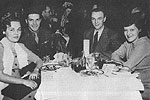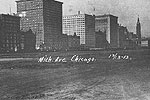
The Loop (continued)
The Chicago created by the streetcars, railroads and elevated
trains became a showplace of American architecture. The fire of
1871 afforded tremendous opportunities to the young architects
who flocked to the city. The Chicago School of Architecture emerged
and actually transformed the way the nation and the world thought
about buildings. The leader of the young architects who came to
Chicago after the Civil War was William Le Baron Jenney. Trained
in Paris, he served in the Union Army as an engineer and came
to Chicago in 1868. Jenney pioneered new structural methods, especially
the skeleton frame, which made it possible to build the first
real skyscraper, the home Insurance Building, in 1884-85. because
of increasing land values and the popularity of downtown locations,
Chicago's buildings became taller and taller, creating the modern
cityscape so familiar to us. Chicago architects Holabird &
Roche, Adler & Sullivan, and Burnham & Root created the
designs that set the style for the American city.
The Chicago Loop also became a major entertainment center (See
Fig. 1). This
was partly a response to the needs of the city, but also those
of the business community and the
convention trade. Hotels were centered in the Loop. Many of them
stood along South Michigan Avenue below
Van Buren Street (See Fig. 2). This hotel district stood
close to the
railroad station of the South Loop; and the railroads, of course,
provided a major form of interurban transportation from the
mid-nineteenth
until the mid-twentieth century. Large railroad stations, like
the Illinois Central Station, the Poll Street Station, the LaSalle
Street Station, and the Grand Central Station, were all in the
South Loop. Other hotels served
the financial and business districts within the area (See
Fig. 3).
This large and vital Loop was largely the result of the technology
of its day, that is, of rail transportation designated for long-distance
hauling and for moving people within the city. The Loop began
to decline in certain respects when the technology changed. This
occurred after World War II as the automobile came into more general
use. The car made it possible to shop in neighborhood shopping
centers and took business away from the center of the city. A
growing trend toward decentralization began in the 1920s and continued
through the 1970s.
The period after 1945 saw the rapid development of suburban shopping
centers that catered to the automobile. Slowly at first, then
much more rapidly, these outlying retail districts drained dollars
away from the Loop. Industries all began to move corporate headquarters
out of the city closer to expressways and especially closer to
O'Hare Airport, to the northwest of the city.
«
previous
9
of 11
next
»
|
 |

|
 |


Figure
1: The Walnut Room in the Bismark Hotel, 1945. »

Figure
2: Michigan Avenue, 1913. »

Figure
3: Blackstone Hotel, Michigan Avenue at Balbo, c. 1909. »
|